Cherry trees are a beautiful addition to any lawn, imparting you with an abundance of fruit and a lovely show of blossoms inside the spring. However, they’re additionally prone to diverse diseases that can affect their boom and general health. Identifying and treating those illnesses is important to make sure that your cherry tree remains healthy and keeps to supply delicious fruit yr after 12 months. In this manual, we are able to speak the 10 maximum commonplace cherry tree sicknesses and provide you with powerful solutions to treat them. From bacterial canker to brown rot, we can cowl all of the important sicknesses that can have an effect on your cherry tree and provide you with the records you want to restore it to its former glory. So, permit’s dive into the world of cherry tree diseases and discover ways to hold your tree blooming and wholesome.
Cherry timber are honestly a sight to behold. With their delicate blossoms and colourful colours, they’ve captivated people round the arena for hundreds of years. These dazzling bushes signify beauty, grace, and the advent of spring. However, like any living organism, cherry timber are not proof against diseases.
Despite their vulnerability, cherry timber show off a excellent resilience that is often underestimated. They have tailored and advanced over the years to combat diverse sicknesses that threaten their fitness. From fungal infections to bacterial illnesses, cherry timber have evolved their personal defense mechanisms to overcome those challenges.
The beauty of cherry trees lies no longer best of their stunning look but also of their ability to resist adversity. They have stood the check of time, weathering storms and persevering via harsh situations. Despite the ability risk of illnesses, cherry bushes preserve to grace our landscapes with their sheer beauty.


As an Amazon Associate we earn from qualifying purchases.
Table of Contents
Cherry tree fanatics look ahead to it every spring: a mass explosion of sunshine pink blossoms. What’s not so thrilling for lovers of the blossoms and their candy fruit is the specter of cherry tree illnesses. If you happen to’ve observed indicators of illness, we’ve collected signs and causes for the seven commonest cherry tree illnesses and how to deal with them.
Indicators of illness may be horrifying. These pathogens can hurt a complete orchard of cherry timber, placing a full halt to any charming blossoms or juicy fruit. Nevertheless, when cherry tree growers execute the suitable preventive measures, they lower their timber’ susceptibility to an infection and improve the probabilities of a vigorous bloom and scrumptious harvest.
Want an expert opinion?
See what an expert analysis will value close to you.
1. Black Knot
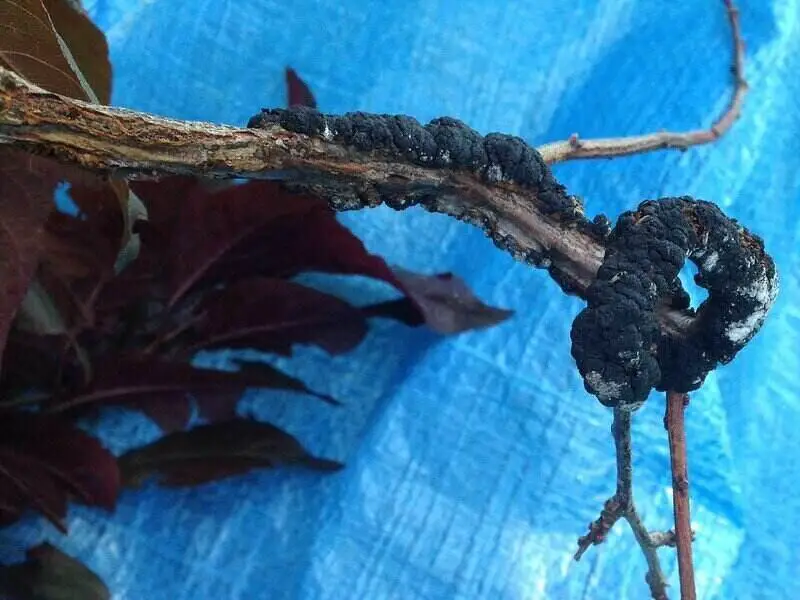

Cherry Timber Affected: A typical decorative cherry tree illness, black knot additionally impacts most Prunus varieties, together with edible and native varieties. Black knot-resistant cherry tree varieties embrace East Asian cherry, North Japanese hill cherry, and Prunus maackii (Manchurian cherry or Amur chokecherry).
Signs: Black knot (Dibotryon morbosum) seems as laborious, black swellings or knots, which can stretch 1-6 inches on the tree. These knots seem in numerous areas across the tree and enlarge when the illness is left untreated.
Velvety, olive-inexperienced fungal progress might cowl the knots. Diseased twigs typically bend due to knot overgrowth. Contaminated branches might wilt, not develop leaves, and can ultimately kill the whole tree.
Causes: By spring and summer season, mature knots produce spores. The rain and wind then carry the black knot fungus spores to prone crops.
The spores can germinate and infect new crops in six hours on the optimum temperature and moist circumstances. By fall, mild brown swellings seem on contaminated twigs. The next spring, the rising knots develop the olive-inexperienced fungal progress. Because the 12 months progresses into summer season and fall, the knots change into laborious, tough, and black.
Therapy: Prune 3-4 inches beneath the knot in the course of the dormant season. Sterilize all pruning tools. Burn or bury all contaminated materials; in any other case, it could nonetheless give you the chance to infect wholesome timber. Take away cherry timber which have a extreme an infection.
The Wisconsin Horticulture Division of Extension doesn’t advocate utilizing fungicides since therapy is pricey and doubtless to be ineffective.
Season: An infection happens from April by way of June.
Threat: Black knot can restrict the manufacturing of cherries and destroy the enchantment of decorative cherry timber.
2. Brown Rot
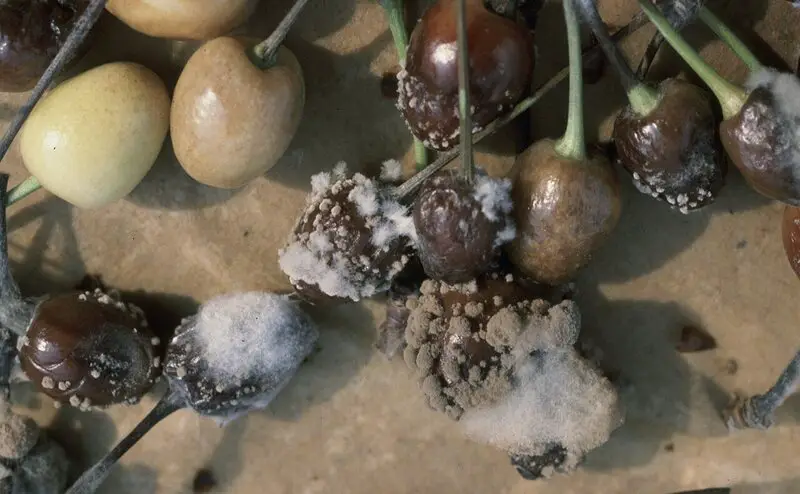

Cherry Timber Affected: Brown rot is an issue for the Kwanzan flowering cherry tree — because it is without doubt one of the most prone cultivars. Additionally it is a standard weeping cherry tree illness. Many stone fruits, together with peach and plum timber, are additionally affected.
Signs: Brown rot (Monilinia fructicola) signs first happen because the browning of blossoms and the dying of twigs. Leaves on the contaminated twigs flip brown and collapse however stay connected to the tree.
When moist climate circumstances are proper, powdery lots of brown-grey spores could also be seen on contaminated fruits, flowers, or twigs.
Causes: If the contaminated blossoms don’t drop off, the an infection can unfold from the flower to the neighboring twig. Twigs then develop cankers, which additional produce fungal spores of the illness.
Brown rot thrives finest in heat, moist circumstances, inflicting an infection to happen in as little as three hours. Bugs can act as spreading brokers for this fungal cherry illness.
Therapy: As soon as brown rot infects your cherries, there aren’t any curable therapies for the fruit. Prune any affected elements of the tree with sanitized pruning instruments 4 to 6 inches beneath the sunken lifeless tissue. Burn or bury the pruned supplies to stop the an infection from spreading.
Thinning your fruit timber encourages airflow, permitting for a drier surroundings to deter the fungus. If brown rot is unmanageable and continues to infect your timber, think about using fungicides.
Season: Brown rot typically assaults cherry timber when in bloom.
Threat: Cherry tree homeowners threat shedding their fruit harvest to this illness.
3. Cherry Leaf Spot
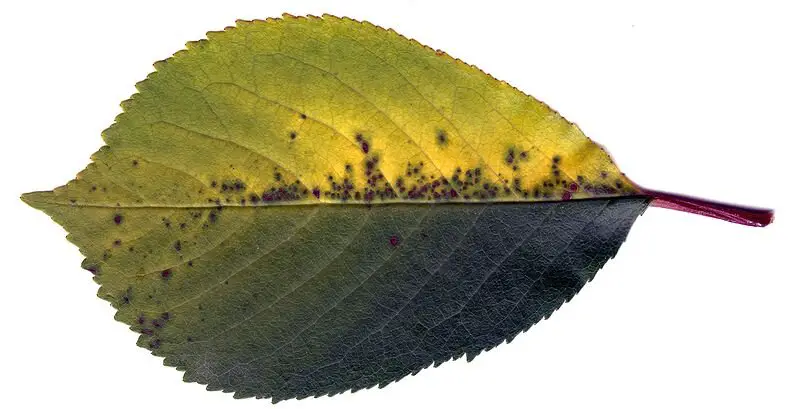

Cherry Timber Affected: Cherry leaf spot (Blumeriella jaapii) assaults tart, candy, and English Morello cherries.
Signs: This illness impacts the cherry tree leaves, and might seem on leaf petioles and fruit pedicels. Small purple spots develop on the higher aspect of the leaf. These spots will enlarge to roughly 1/4-inch in diameter and flip a reddish-brown coloration.
After six to eight weeks, the facilities of the spots might dry up and fall out, creating small holes within the leaf. Generally older contaminated leaves might flip golden yellow earlier than falling off. Cherry leaves contaminated with cherry leaf spot might fall prematurely. Don’t confuse it for leaf scorch, which has related signs: cherry tree leaves turning brown and curling as a substitute of falling off.
Causes: This fungal illness overwinters in lifeless cherry leaves on the bottom. In early spring, apothecia (fruiting our bodies) develop on the leaves and produce spores. Rainfall spreads these spores to wholesome leaves the place the spores germinate and penetrate the leaf.
The small purple spots start to seem on the leaf after an infection. As soon as these spots have developed, their undersides create extra fungal spores (conidia), which seem as whitish-pink underleaf lesions. Rain then spreads the conidia to different wholesome cherry timber and creates new infections.
Therapy: Collect and destroy all fallen leaves to stop the fungus from overwintering. Eradicating leaves is an efficient resolution for yard cherry tree rising, nevertheless it has limitations for giant cherry orchards. When planting your cherry tree, guarantee to expose it to direct daylight and good air circulation (pruning can obtain this).
In industrial orchards, fungicide is one of the best technique to management the illness. The Ohio State University Extension recommends Bulletin 506 for industrial growers and Bulletin 780 for yard cherry tree growers.
Season: The purple spots seem on cherry leaves between the top of Might and the start of June.
Threat: A cherry tree with a extreme an infection might defoliate by mid-summer season. Early and repeated defoliation might trigger unripe fruit with poor style. Cherry timber change into extra prone to winter damage, lifeless fruit spurs (fruit-bearing branches), lack of fruit, weak buds, and doable tree dying.
4. Cytospora Canker
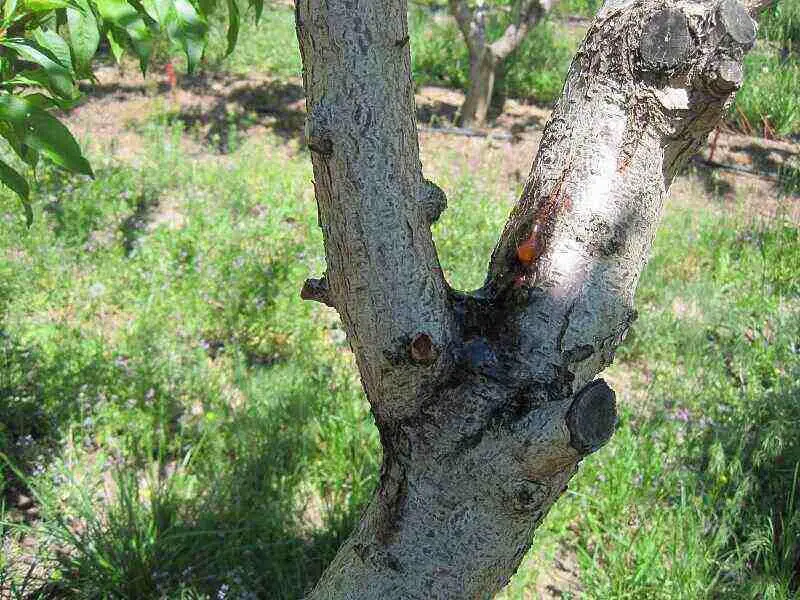

Cherry Timber Affected: Cytospora canker (Leucostoma kunze) is without doubt one of the most harmful illnesses to candy and bitter cherries.
Signs: Cherry tree branches develop darkish, depressed cankers that trigger the tree department to wilt. An amber-coloured gum might seem on the fringe of the canker. The canker will ultimately girdle the limb and you’ll discover elements of the cherry tree dying.
Causes: Black pycnidia, spore-producing constructions, seem on the canker. These black pycnidia will flip white over time. In humid circumstances, spore lots expel from the pycnidia. Rain and wind carry the spores to infect any bark wound. These wounds might end result from sunburn, previous cankers, or wooden-boring bugs.
This illness can’t assault wholesome, undamaged bark. A cherry tree’s susceptibility to Cytospora canker will increase when it’s careworn from drought, nutrient deficiency (i.e. low potassium), overcropping, and ring nematodes.
Therapy: There isn’t any chemical management for Cytospora canker. Management an infection by limiting tree stress. Prune your contaminated cherry tree in the course of the rising season when it’s simpler to determine the cankers and limbs with dieback.
Season: Cytospora canker thrives in the summertime when temperatures are above 90 levels. Lifeless limbs girdled by cankers seem in mid to late summer season.
Threat: Fashioned cankers will kill elements of your cherry tree.
5. Powdery Mildew
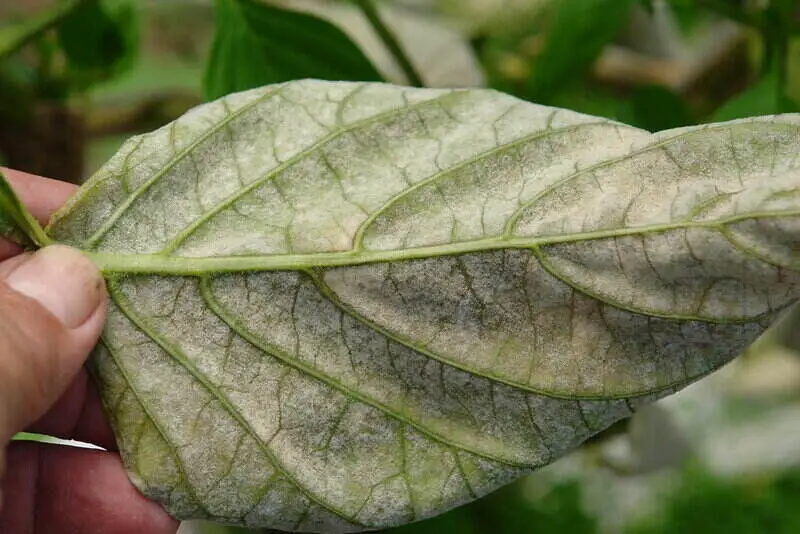

Cherry Timber Affected: Candy and bitter cherry timber are probably the most prone to powdery mildew (Podosphaera clandestina). Powdery mildew can be a standard weeping cherry tree downside.
Signs: Gentle powdery patches seem on younger cherry leaves. Older leaves are much less doubtless to have powdery patches as they might have resistance to powdery mildew. Contaminated leaves might distort, twist, or develop pale. A white fungus might develop on the stem finish of the cherry.
Causes: Within the fall, small constructions ((*7*)) containing ascospores lie dormant in leaves or the place tree limbs come collectively (crotches). Throughout rainfall or irrigation, these constructions launch the ascospores. The wind carries the ascospores to infect younger leaves.
By fall, the fungal an infection enters its overwintering stage within the chasmothecia to repeat the cycle subsequent season. This illness favors humid circumstances and temperatures between 70 to 80 levels.
Therapy: Keep away from early irrigation as this will trigger untimely powdery mildew infections to rise. The bottom ought to nonetheless be moist within the spring, and pointless watering might trigger powdery mildew to start an infection. In accordance to Washington State University, a two-week delay in irrigation can delay the illness with no detrimental influence on the fruit.
Pruning your cherry tree will encourage airflow and leaf dryness. If utilizing fungicides as therapy, remember the fact that most fungicides are a safety measure and don’t remedy the illness.
Season: Follow preventive administration strategies all through the complete fungal rising seasons in late summer season and early fall.
Threat: Mid-and-late-season candy cherries are generally affected. Powdery mildew might destroy your cherry fruit with a white fungal progress on the cherry floor.
6. Necrotic Ringspot
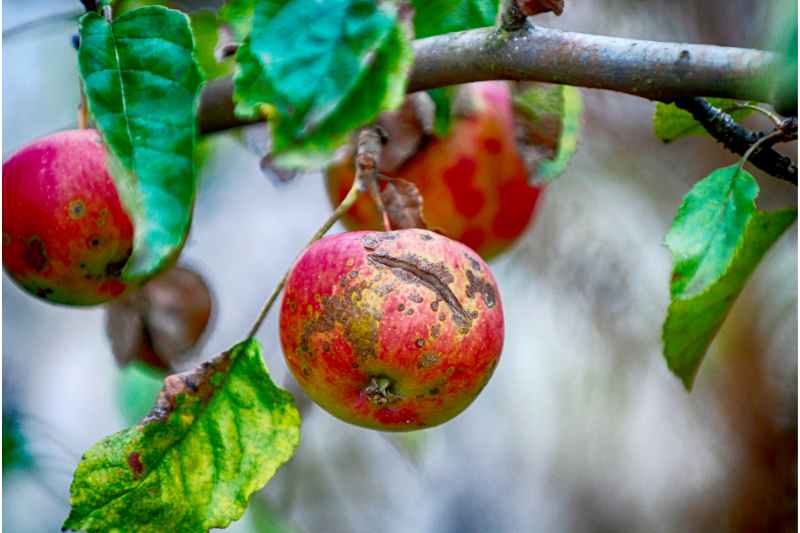

Cherry Timber Affected: Necrotic ringspot assaults candy and bitter cherries.
Signs: Signs embrace yellowing and browning of cherry leaves. Leaves develop holes, giving them a shothole look. Leaves might drop in early summer season, and the cherry fruit might deform or mature later than standard.
The unfold of this illness is way slower in candy cherries than in bitter cherries. Enations or raised projections will type on the underside of leaves, giving a thick and stiff look.
Causes: The virus, Prunus necrotic ringspot virus (PNRSV), spreads by way of pollen, seed, and wooden grafting. Wind and pollinators can unfold contaminated pollen all through a complete orchard.
Therapy: Take away symptomatic timber to stop unfold to different cherry timber.
Threat: Necrotic ringspot might stunt your tree’s progress and kill its twigs, buds, and foliage. PNRSV could cause fruit losses of up to 15% in candy cherries and up to 100% in peaches.
7. Silver Leaf


Cherry Timber Affected: Candy and bitter cherries are generally affected by silver leaf.
Signs: The primary symptom of silver leaf (Chondrostereum purpureum) is a silver sheen on the affected leaves. The exact variety of leaves affected will differ from tree to tree. The silvery leaves might develop brown, lifeless patches, and leaf signs might not seem 12 months after 12 months.
If they seem one 12 months, they might not reappear the following. Don’t mistake the dearth of signs for a full restoration. Branches with symptomatic leaves might have a darkish stain working beneath them. In diseased timber, it’s possible you’ll discover a white fungus on the cherry tree bark with noticeable purple-brown conks.
Causes: The conks are reproductive constructions of the illness-inflicting fungus. The fungus is launched from the conks throughout moist circumstances in autumn and spreads and infects timber with open wounds. The fungus then lives within the water-conducting tissue of branches (xylem). Its presence within the xylem is what causes the darkish stain.
The fungus releases a toxin, which then travels to the leaves and causes a silvery look. The dermis (the floor layer) separating from the remainder of the leaf blade causes the metallic sheen. This separation impacts the reflection of sunshine. Because the wooden decays, the illness begins to develop the fungus-producing conks on the wooden.
Therapy: Prune branches exhibiting any leaf signs or indicators of conks. Prune branches at the least 4 inches beneath the place staining and conks are seen. Mark your diseased timber. This fashion, when signs don’t reappear the next 12 months, you’ll know to pay shut consideration to that specific tree.
Because the fungus limits water motion in branches, present sufficient water, about 10 gallons of water for every inch of the tree’s diameter, for the diseased timber. No fungicides can be found to deal with this illness.
Season: Prune contaminated timber throughout dry winter durations when temperatures are beneath 32 levels. Pruning right now will assist stop the unfold of silver leaf. If pruning within the rising season, guarantee you’re doing it in dry circumstances.
Threat: Silver leaf will trigger a sluggish decline in your cherry tree’s well being and fruit yield.
8. Blossom blight
Blossom blight may be a irritating and destructive sickness for cherry tree owners. It is because of a fungal pathogen that attacks the blossoms of the tree, main to a decline in fruit production and normal tree health. Understanding the causes, signs and symptoms, and remedy alternatives for blossom blight is important in efficiently dealing with this disease.
Causes:
Blossom blight is primarily resulting from fungal pathogens, along with Monilinia spp. These pathogens thrive in warm and humid situations, making cherry trees prone in the course of periods of wet climate. The disease can also unfold through inflamed plant cloth or pruning tools, so proper sanitation practices are critical in stopping its unfold.
Symptoms:
The preliminary symptoms of blossom blight may be diffused and effortlessly unnoticed. Look out for wilting or browning blossoms that fail to develop into wholesome fruit. As the disease progresses, the inflamed blossoms may flip brown and shrivel up, reminiscent of a “mummified” appearance. In intense instances, the contamination can unfold from the blossoms to the shoots and branches of the tree.
Treatment options:
1. Prune infected blossoms: As soon as you note signs of blossom blight, promptly prune and do away with any inflamed blossoms. This enables save you the sickness from spreading further and decreases the fungal load at the tree.
2. Fungicide applications: To correctly manipulate blossom blight, the strategic use of fungicides is usually recommended. Consult with a local arborist or horticulturist to identify the most suitable fungicide on your precise cherry tree range and follow the instructions carefully for utility timing and dosage.
3. Cultural practices: Implementing desirable cultural practices can help lessen the risk of blossom blight. Ensure right spacing among timber to enhance air circulate, prune to hold an open canopy, and eliminate any fallen leaves or fruit particles from across the tree.
Four. Disease-resistant varieties: Consider planting cherry tree types that are acknowledged for their resistance to blossom blight. These sorts were bred to resist fungal infections and may be a treasured asset in dealing with the disease.
9. Cherry leaf spot
Cherry leaf spot is a commonplace disorder that influences cherry trees, causing unsightly spots at the leaves and reducing the overall fitness and power of the tree. It is resulting from the fungus Blumeriella jaapii and can cause defoliation if left untreated. However, with proper prevention and treatment methods, you could preserve your cherry tree wholesome and thriving.
Prevention is key on the subject of handling cherry leaf spot. Start with the aid of deciding on resistant cherry tree varieties which are less at risk of the disease. Additionally, ensure proper spacing among bushes to allow for good air circulate, as this will assist save you the unfold of the fungus. Regularly look into your trees for any symptoms of contamination and directly put off any inflamed leaves or branches to prevent the sickness from spreading similarly.
When it involves remedy, there are numerous options to be had. Fungicidal sprays can be used to govern cherry leaf spot, with packages typically starting in spring before signs and symptoms seem and persevering with all through the growing season. Be sure to follow the commands at the fungicide label and practice it flippantly to all parts of the tree, paying unique interest to the undersides of the leaves in which the fungus tends to thrive.
In addition to fungicidal sprays, cultural practices can also useful resource within the treatment of cherry leaf spot. Avoid overhead watering, as this will create a favorable surroundings for the fungus to spread. Instead, opt for drip irrigation or watering at the bottom of the tree. Mulching across the base of the tree also can help retain soil moisture and prevent the unfold of spores.
Regularly monitoring your cherry tree’s health and taking prompt action at the primary signs and symptoms of cherry leaf spot can greatly lessen the effect of the disease. By following these prevention and remedy pointers, you may make certain that your cherry trees stay wholesome, vibrant, and unfastened from the results of cherry leaf spot.
10. Fire blight
Fire blight is a destructive bacterial contamination which could wreak havoc to your precious cherry timber. It receives its call from the scorched look it leaves on affected branches, as though they were fed on with the aid of fireplace. As one of the maximum common and contagious sicknesses that cherry bushes can face, it’s miles essential to understand the signs and symptoms early and take instantaneous action to manage and prevent its spread.
The first signs of fire blight normally seem in spring while the weather is warm and humid. Blossoms and young shoots will turn brown or black, corresponding to a burnt look. The contamination then progresses rapidly, getting into branches and causing wilting, blackening, and demise of the affected regions. If left untreated, fireplace blight can quickly spread at some point of the tree, main to severe harm or maybe loss of life.
To efficaciously manipulate fireplace blight, prompt movement is essential. Start by using pruning off any infected branches, making sure to make cuts as a minimum 12-18 inches under the seen signs and symptoms. Sterilize your pruning gear with a bleach answer between cuts to prevent spreading the micro organism. Dispose of the inflamed branches some distance away from wholesome trees or burn them to cast off the bacteria.
Applying the suitable bactericide spray can also resource in coping with fire blight. Copper-based totally sprays are generally used to control bacterial infections in cherry timber. These sprays must be implemented during the dormant season or before the onset of signs and symptoms in the spring. Follow the commands furnished by way of the producer and ensure thorough insurance of all branches and blossoms.
Preventing fire blight calls for proactive measures as nicely. Choose resistant cherry tree sorts each time possible, as they’re much less vulnerable to the sickness. Avoid over-fertilizing your trees, as immoderate nitrogen can create conditions favorable for bacterial boom. Proper pruning strategies, along with open-middle pruning, can assist growth airflow and reduce moisture, making the tree much less prone to infections.
Regularly monitoring your cherry trees for any signs of hearth blight or different illnesses is vital for early detection and powerful control. By right away addressing and treating this bacterial contamination, you can defend the health and energy of your cherry bushes, making sure their persisted beauty and bountiful harvests for years yet to come.
FAQ About Common Cherry Tree Diseases
1. Why Are My Cherry Tree Leaves Turning Brown?
Cherry tree leaves often flip brown from improper watering, climate stress, or cherry illnesses similar to cherry leaf spot or brown rot.
2. Why Is My Cherry Tree Shedding Leaves In Summer season?
Excessive warmth and drought could make leaves drop off in addition to illnesses like cherry leaf spot.
Excessive environmental factors may also be why some cherry timber are dying throughout spring: Extended spring rains could cause root harm, whereas very dry summers could cause water stress.
Moreover, fast drops in temperatures throughout fall and late spring frost occasions could cause freeze harm. If one among these occasions is adopted by one other, it turns into more and more more durable for the tree to get well, inflicting it will definitely to die.
3. What Are The Signs Of Cherry Tree Fungus?
It could actually differ primarily based on the fungus. Black swellings or knots, silver leaves, mild powdery patches, depressed cankers, and leaves falling off are all indicators of an issue.
4. How Do I Sanitize My Pruning Instruments?
Ethanol or isopropyl alcohol is good for sanitizing pruning tools as a result of blades can merely be wiped or dipped into disinfectant with out a extended soak.
5. What Cherry Timber Are Black Knot-Resistant?
Black knot-resistant cherry tree varieties embrace East Asian cherry, North Japanese hill cherry, and Prunus maackii (Manchurian cherry or Amur chokecherry).
© 2024 Lotusmagus.com. All rights reserved. This content is protected by copyright. Visit Lotusmagus.com for more information.

